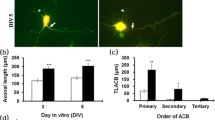Abstract
Neurotrophic factors are essential for the differentiation and maturation of developing neurons as well as providing survival support to the mature neurons. Moreover, therapeutically neurotrophic factors are promising to reconstruct partially damaged neuronal networks in neurodegenerative diseases. In the previous study, we reported that the ethanol extract of an edible marine alga, Gelidium amansii (GAE) had shown promising effects in the development and maturation of both axon and dendrites of hippocampal neurons. Here, we demonstrate that in primary culture of hippocampal neurons (1) GAE promotes a significant increase in the number of filopodia and dendritic spines; (2) promotes synaptogenesis; (3) enhances N-methyl-d-aspartic acid (NMDA) receptor recruitment; and (4) modulates NMDA-receptor-mediated postsynaptic current. Taken together these findings that GAE might be involved in both morphological and functional maturation of neurons suggest the possibility that GAE may constitute a promising candidate for novel compounds for the prevention and treatment of neurodegenerative diseases.




Similar content being viewed by others
References
Cho S. J.; Lee H.; Dutta S.; Song J.; Walikonis R.; Moon I. S. Septin 6 regulates the cytoarchitecture of neurons through localization at dendritic branch points and bases of protrusions. Mol. Cells. 32: 89–98; 2011.
Crozier R. A.; Black I. B.; Plummer M. R. Blockade of NR2B-containing NMDA receptors prevents BDNF enhancement of glutamatergic transmission in hippocampal neurons. Learn. Mem. 6: 257–266; 1999.
Dickson T. C.; Vickers J. C. The morphological phenotype of β-amyloid plaques and associated neuritic changes in Alzheimer’s disease. Neuroscience 105: 99–107; 2001.
Gasparini S.; Saviane C.; Voronini L. L.; Cherubini E. Silent synapses in the developing hippocampus: lack of functional AMPA receptors or low probability of glutamate release? Proc. Natl. Acad. Sci. U. S. A. 97: 9741–9746; 2000.
Ghosh A.; Greenberg M. E. Distinct roles for bFGF and NT-3 in the regulation of cortical neurogenesis. Neuron 15: 89–103; 1995.
Goslin K.; Asmussen H.; Banker G. Rat hippocampal neurons in low density culture. In: Banker G.; Goslin K. (eds) Culturing nerve cells. MIT Press, Cambridge, MA, pp 339–370; 1998.
Greene L. A.; Tischler A. S. Establishment of a noradrenergic clonal line of rat adrenal pheochromocytoma cells which respond to nerve growth factor. Proc. Natl. Acad. Sci. U. S. A. 73: 2424–2428; 1976.
Hannan M. A.; Kang J. Y.; Hong Y. K.; Lee H.; Choi J. S.; Choi I. S.; Moon I. S. The marine alga Gelidium amansii promotes the development and complexity of neuronal cytoarchitecture. Phytother. Res. 27: 21–29; 2013.
Hannan M. A.; Kang J. Y.; Hong Y. K.; Lee H.; Chowdhury M. T. H.; Choi J. S.; Choi I. S.; Moon I. S. A brown alga Sargassum fulvellum facilitates neuronal maturation and synaptogenesis. In Vitro Cell. Dev. Biol. Anim. 48: 535–544; 2012.
Harris K. M.; Kater S. B. Dendritic spines: cellular specializations imparting both stability and flexibility to synaptic function. Annu. Rev. Neurosci. 17: 341–371; 1994.
Ippolito D. M.; Eroglu C. Quantifying synapses: an immunocytochemistry-based assay to quantify synapse number. J. Vis. Exp. 45: e2270; 2010.
Kolb J. E.; Trettel J.; Levine E. S. BDNF enhancement of postsynaptic NMDA receptors is blocked by ethanol. Synapse 55: 52–57; 2005.
Levine E. S.; Crozier R. A.; Black I. B.; Plummer M. R. Brain-derived neurotrophic factor modulates hippocampal synaptic transmission by increasing N-methyl-d-aspartic acid receptor activity. Proc. Natl. Acad. Sci. U. S. A. 95: 10235–10239; 1998.
Moon I. S. Relative extent of tyrosine phosphorylation of the NR2A and NR2B subunits in the rat forebrain postsynaptic density fraction. Mol. Cells. 16: 28–33; 2003.
Moon I. S.; Apperson M. L.; Kennedy M. B. The major tyrosine-phosphorylated protein in the postsynaptic density fraction is N-methyl-d-aspartate receptor subunit 2B. Proc. Natl. Acad. Sci. U. S. A. 91: 3954–3958; 1994.
Moon I. S.; Cho S. J.; Jin I.; Walikonis R. A simple method for combined fluorescence in situ hybridization and immunocytochemistry. Mol. Cells 24: 76–82; 2007.
Neves G.; Cooke S. F.; Bliss T. V. Synaptic plasticity, memory and the hippocampus: a neural network approach to causality. Nat. Rev. Neurosci. 9: 65–75; 2008.
Papa M.; Bundman M. C.; Greenberger V.; Segal M. Morphological analysis of dendritic spine development in primary cultures of hippocampal neurons. J. Neurosci. 15: 1–11; 1995.
Rao A.; Kim E.; Sheng M.; Craig A. M. Heterogeneity in the molecular composition of excitatory postsynaptic sites during development of hippocampal neurons in culture. J. Neurosci. 18: 1217–1229; 1998.
Renger J. J.; Egles C.; Liu G. A developmental switch in neurotransmitter flux enhances synaptic efficacy by affecting AMPA receptor activation. Neuron 29: 469–484; 2001.
Vicario-Abejon C.; Collin C.; McKay R. D.; Segal M. Neurotrophins induce formation of functional excitatory and inhibitory synapses between cultured hippocampal neurons. J. Neurosci. 18: 7256–7271; 1998.
Vicario-Abejón C.; Owens D.; McKay R.; Segal M. Role of neurotrophins in central synapse formation and stabilization. Nat. Rev. Neurosci. 3: 965–974; 2002.
Wang T.; Xie K.; Lu B. Neurotrophins promote maturation of developing neuromuscular synapses. J. Neurosci. 15: 4796–4805; 1995.
Acknowledgments
MAH wishes to thank the National Institute for International Education (NIIED), Korea, for graduate assistance.
Author information
Authors and Affiliations
Corresponding author
Additional information
Editor: T. Okamoto
Rights and permissions
About this article
Cite this article
Hannan, M.A., Mohibbullah, M., Hong, YK. et al. Gelidium amansii promotes dendritic spine morphology and synaptogenesis, and modulates NMDA receptor-mediated postsynaptic current. In Vitro Cell.Dev.Biol.-Animal 50, 445–452 (2014). https://doi.org/10.1007/s11626-013-9721-2
Received:
Accepted:
Published:
Issue Date:
DOI: https://doi.org/10.1007/s11626-013-9721-2




